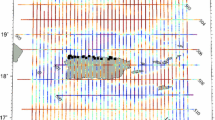Abstract
For both airborne gravimetric and airborne magnetic surveys, systematic residual errors usually remain in the data after standard data processing. In the literature, the mismatches at the crossover points are used to either adjust the processing procedures or directly adjust the results. This is usually called crossover adjustment. Due to the limited crossover points, it has a risk of leaking the random errors into a systematic distortion of the entire data. In aeromagnetic surveys, the low-wavenumber information is used to construct a smooth field to level the survey data without the need for tie lines. However, this method relies on the long-wavelength component of the flight line data accurately sampling the regional field. Here, an alternative approach is developed to model the physical field using radial basis functions (RBF) and to parameterize the systematic errors at the same time, which avoids all of the aforementioned problems. Numerical results show that the new method provides more stable results than the classical approach. The method is also tested on terrestrial gravity surveys (where it is challenging to directly apply the crossover analysis). Here also, it yields promising results.








Similar content being viewed by others
References
Bell RE, Childers VA, Arko RA, Blankenship DD, Brozena JM (1999) Airborne gravity and precise positioning for geologic applications. J Geophys Res 104(B7):15281–15292
Bentel K, Schmidt M, Gerlach C (2013) Different radial basis functions and their applicability for regional gravity field representation on sphere. GEM-International Journal on Geomathematics 4:67–96
Eicker A (2008) Gravity field refinement by radial basis functions from in-situ satellite data. Ph.D. Thesis University of Bonn, Bonn
Gilardoni M, Reguzzoni M, Sampietro D (2016) GECO: a global gravity model by locally combining GOCE data and EGM2008. Stud Geophys Geod 60(2):228–247
Heiskanen WA, Mortiz H (1967) Physical Geodesy. Freeman, San Francisco
Huang, J., S. A. Holmes, D. Zhong, M. Véronneau, Y. Wang, J. W. Crowley, X. Li, and R. Forsberg, 2017, Analysis of the GRAV-D airborne gravity data for geoid modelling. In: Vergos G., Pail R., Barzaghi R. (eds) International Symposium on Gravity, Geoid and Height Systems 2016. International Association of Geodesy Symposia, vol 148. Springer, Cham. https://doi.org/10.1007/1345_2017_23
Hwang C, Hsiao YS, Shih HC (2006) Data reduction in scalar airborne gravimetry: theory, software and case study in Taiwan. Computer & Geosciences 32:1573–1584
Jekeli C (2005) Spline representation of functions on a sphere for geopotential modeling, Technical report 475. Department of Geodetic Science, the Ohio State University
Jekeli C (2016) Theoretical fundamentals of airborne gravimetry, NGS summer school. https://www.ngs.noaa.gov/GRAV-D/2016SummerSchool/presentations/day-1/2Jekeli_Theoretical_Fundamentals.pdf. Accessed 5 Oct 2021
Klees R, Wittwer T (2007) Local gravity field modelling with multipole wavelets. In: Tregoning P, Rizos C (eds) Dynamic planet—monitoring and understanding a dynamic planet with geodetic and oceanographic tools. In: International association of geodesy symposia, vol 130. Springer, Berlin, pp 303–308
Klees R, Tenzer R, Prutkin I, Wittwer T (2008) A data-driven approach to local gravity field modeling using spherical radial basis functions. J Geodesy 82:457–471
Li, X. and C. Jekeli, 2008, Ground-Vehicle INS/GPS Gravimetry, Geop., 73, 2, I1-I10. Li X., 2011a, Strapdown INS/DGPS airborne gravimetry tests in the Gulf of Mexico, J Geod., 85, 9, 597–605, https://doi.org/10.1007/s00190-011-0462-2
Li X (2011a) An exact formula for the tilt correction in scalar airborne gravimetry. Journal of Applied Geodesy 5(2):81–85
Li X (2011b) Strapdown INS/DGPS airborne gravimetry tests in the Gulf of Mexico. J Geod 85(9):597–605. https://doi.org/10.1007/s00190-011-0462-2
Li X (2013) Examination of two major approximations used in the scalar airborne gravimetric system — a case study based on the LCR system. Journal of Geodetic Science 3(1):32–39. https://doi.org/10.2478/jogs-2013-0004
Li X, Götze HJ (2001) Tutorial ellipsoid, geoid, gravity, geodesy, and geophysics. Geophysics 66(6):1660–1668
Li X, Huang J, Klees R, Forsberg R, Willberg M, Slobbe C, Hwang C, Pail R (2021) Characterization and stabilization of the downward continuation problem for airborne gravity, in the reviewing process of Journal of Geodesy
Luyendyk APJ (1997) Processing of airborne magnetic data. Journal of Australian Geology & Geophysics 17(2):31–38
Naeimi M (2013) Inversion of satellite gravity data using spherical radial base functions. PhD thesis, Institute of Geodesy, University of Hanover, Germany
Olesen AV (2002) Improved airborne scalar gravimetry for regional gravity field mapping and geoid determination. Ph.d. dissertation, National Survey and Cadastre of Denmark Technical Report 24:123
Saleh J, Li X, Wang YM, Roman DR, Smith DA (2013) Error analysis of the NGS surface gravity database. J Geodesy 87(3):203–221
Schmidt M, Fengler M, Mayer-Guerr T, Eicker A, Kusche J, Sanchez L, Han SC (2007) Regional gravity field modeling in terms of spherical base functions. J Geod 81(1):17–38
Schwarz, K.P., and Z. Li, 1997, An introduction to airborne gravimetry and its boundary value problems. In: Sansó F., Rummel R. (eds) Geodetic Boundary Value Problems in View of the One Centimeter Geoid. Lecture Notes in Earth Sciences, vol 65. Springer, Berlin, Heidelberg. https://doi.org/10.1007/BFb0011709
Smith DA (2007) The GRAV-D project: Gravity for the Redefinition of the American Vertical Datum, http://www.noaa.gov/GRAV-D/pubs/GRAVDv20071219.pdf, accessed 20 March 2017
Thomson W, Tait PG (1867) Treatise on Natural Philosophy. Oxford University Press
White JC, Beamish D (2015) Levelling aeromagnetic survey data without the need for tie-lines. Geophys Prospect 63:451–460
Acknowledgements
The author sincerely thanks the useful comments from the reviewer.
Author information
Authors and Affiliations
Corresponding author
Rights and permissions
About this article
Cite this article
Li, X. Leveling airborne and surface gravity surveys. Appl Geomat 13, 945–951 (2021). https://doi.org/10.1007/s12518-021-00402-2
Received:
Accepted:
Published:
Issue Date:
DOI: https://doi.org/10.1007/s12518-021-00402-2




